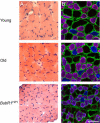Diaphragm muscle sarcopenia in aging mice
- PMID: 23792145
- PMCID: PMC3750110
- DOI: 10.1016/j.exger.2013.06.001
Diaphragm muscle sarcopenia in aging mice
Abstract
Sarcopenia, defined as muscle weakness and fiber atrophy, of respiratory muscles such as the diaphragm (DIAm) has not been well characterized. The DIAm is the main inspiratory muscle and knowledge of DIAm sarcopenia is important for establishing the effects of aging on respiratory function. We hypothesized that aging is associated with a loss of DIAm force and reduced fiber cross-sectional area (CSA), and that these changes vary across fiber types. DIAm sarcopenia was assessed in young (5 month; n = 11) and old (23 month; n = 12) wild-type mice reflecting ~100 and 75% survival, respectively. In addition, DIAm sarcopenia was evaluated in BubR1(H/H) mice (n = 4) that display accelerated aging (~60% survival at 5 months) as a result of expression of a hypomorphic allele (H) of the mitotic checkpoint protein BubR1. Maximum specific force (normalized for CSA) of the DIAm was 34% less in old mice and 57% lower in BubR1(H/H) mice compared to young mice. Mean CSA of type IIx and/or IIb DIAm fibers was 27% smaller in old wild-type mice and 47% smaller in BubR1(H/H) mice compared to young mice. Mean CSA of type I or IIa fibers was not different between groups. Collectively these results demonstrate sarcopenia of the DIAm in aging wild-type mice and in BubR1(H/H) mice displaying accelerated aging. Sarcopenia may limit the ability of the DIAm to accomplish expulsive, non-ventilatory behaviors essential for airway clearance. As a result, these changes in the DIAm may contribute to respiratory complications with aging.
Keywords: Atrophy; Contractile properties; Cross-sectional area; Fiber type; Myosin heavy chain; Respiratory muscles.
Copyright © 2013 Elsevier Inc. All rights reserved.
Figures




References
-
- Ameredes BT, Zhan W-Z, Vanderboom R, Prakash YS, Sieck GC. Power fatigue of the rat diaphragm muscle. J Appl Physiol. 2000;89:2215–2219. - PubMed
-
- Baker DJ, Jeganathan KB, Cameron JD, Thompson M, Juneja S, Kopecka A, Kumar R, Jenkins RB, de Groen PC, Roche P, van Deursen JM. BubR1 insufficiency causes early onset of aging-associated phenotypes and infertility in mice. Nat Genet. 2004;36:744–749. - PubMed
-
- Cesari M, Fielding RA, Pahor M, Goodpaster B, Hellerstein M, Van Kan GA, Anker SD, Rutkove S, Vrijbloed JW, Isaac M, Rolland Y, M'Rini C, Aubertin-Leheudre M, Cedarbaum JM, Zamboni M, Sieber CC, Laurent D, Evans WJ, Roubenoff R, Morley JE, Vellas B. Biomarkers of sarcopenia in clinical trials-recommendations from the International Working Group on Sarcopenia. J Cachexia Sarcopenia Muscle. 2012;3:181–190. - PMC - PubMed
Publication types
MeSH terms
Substances
Grants and funding
LinkOut - more resources
Full Text Sources
Other Literature Sources
Medical
Molecular Biology Databases
Research Materials

